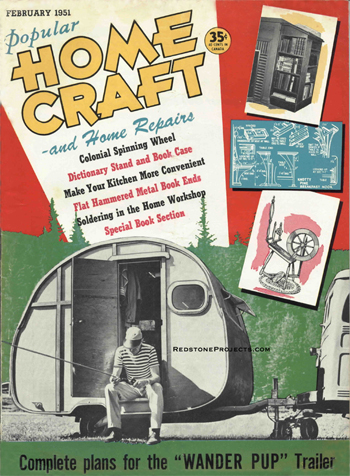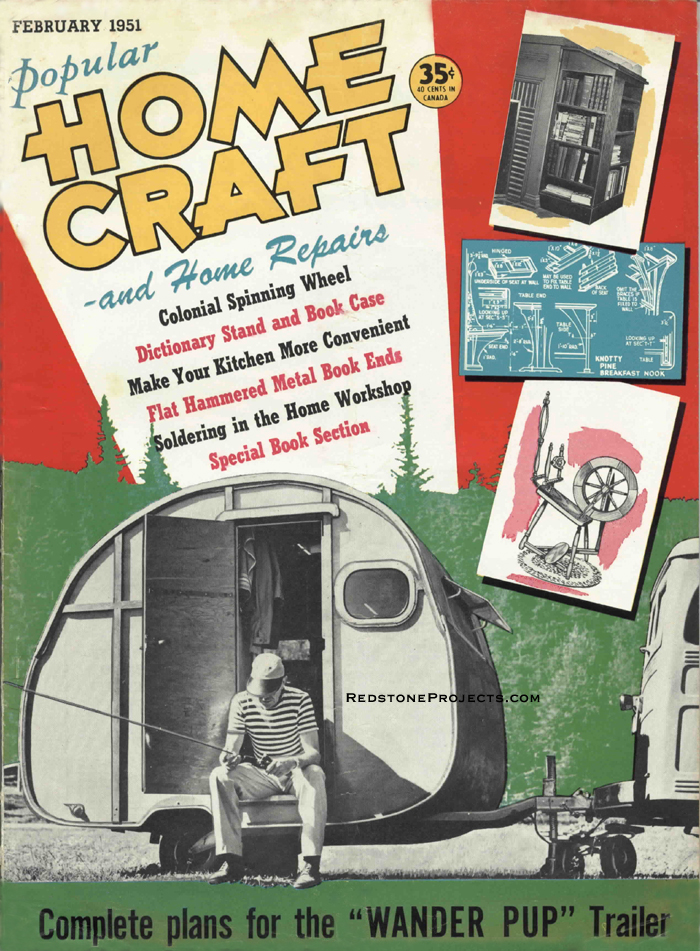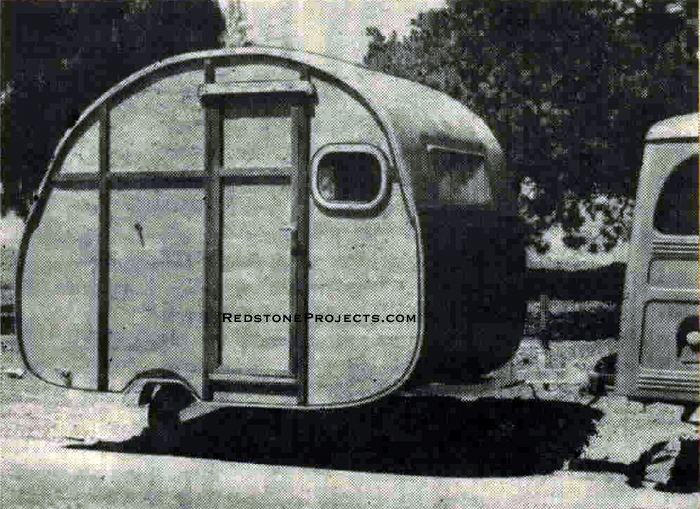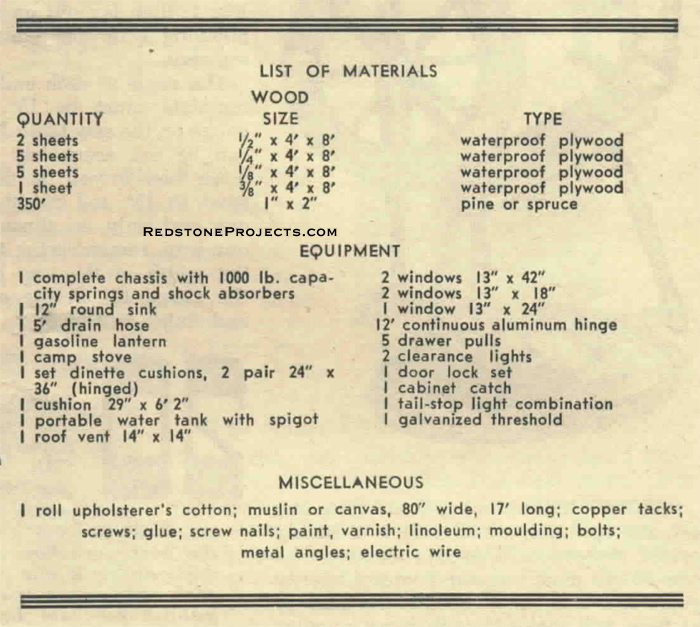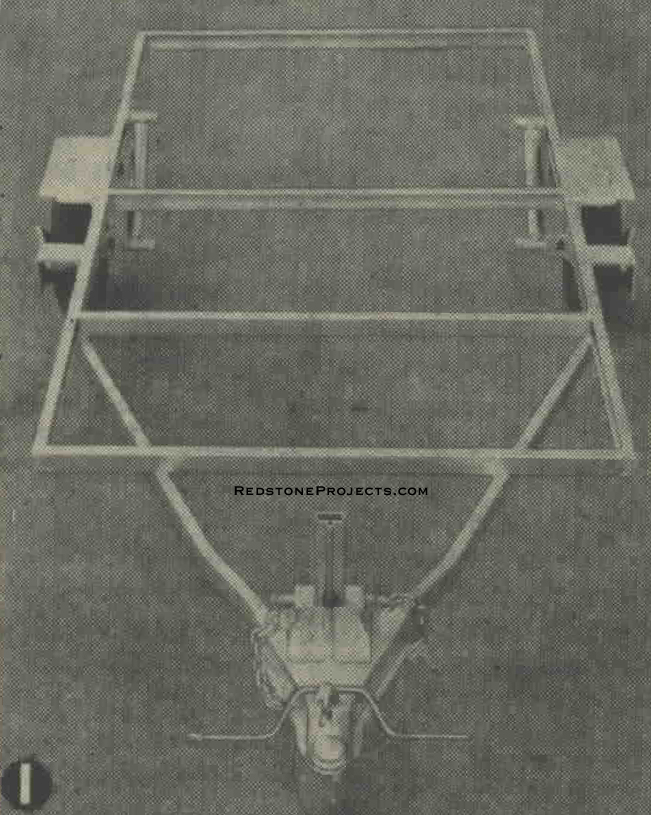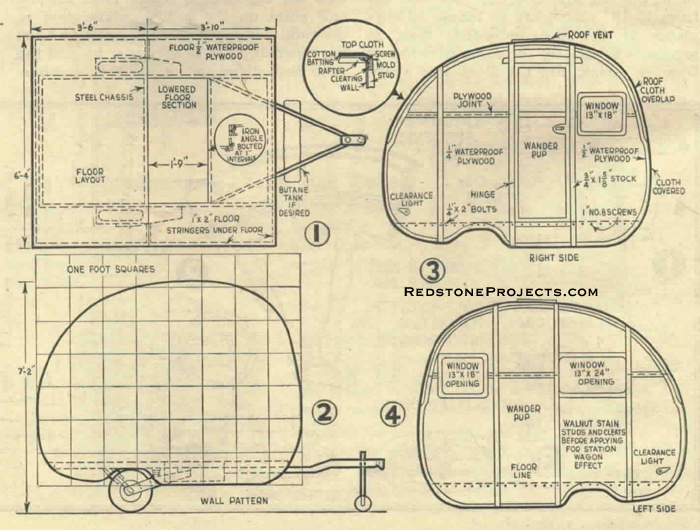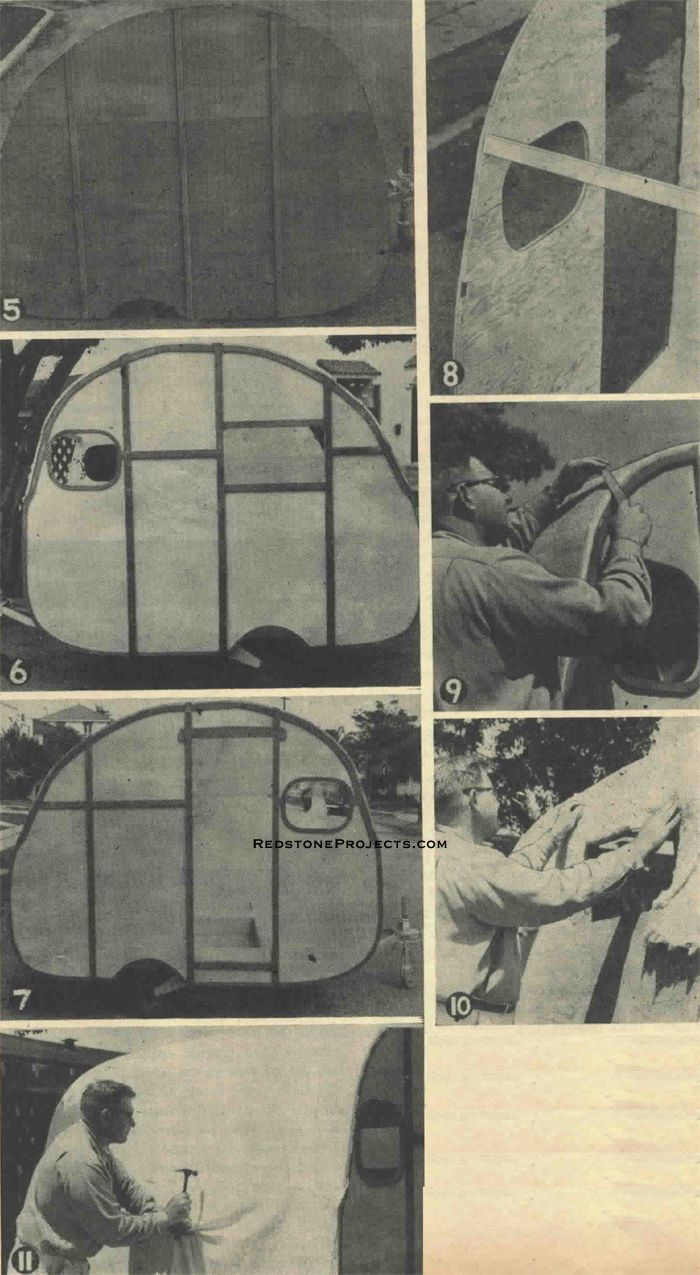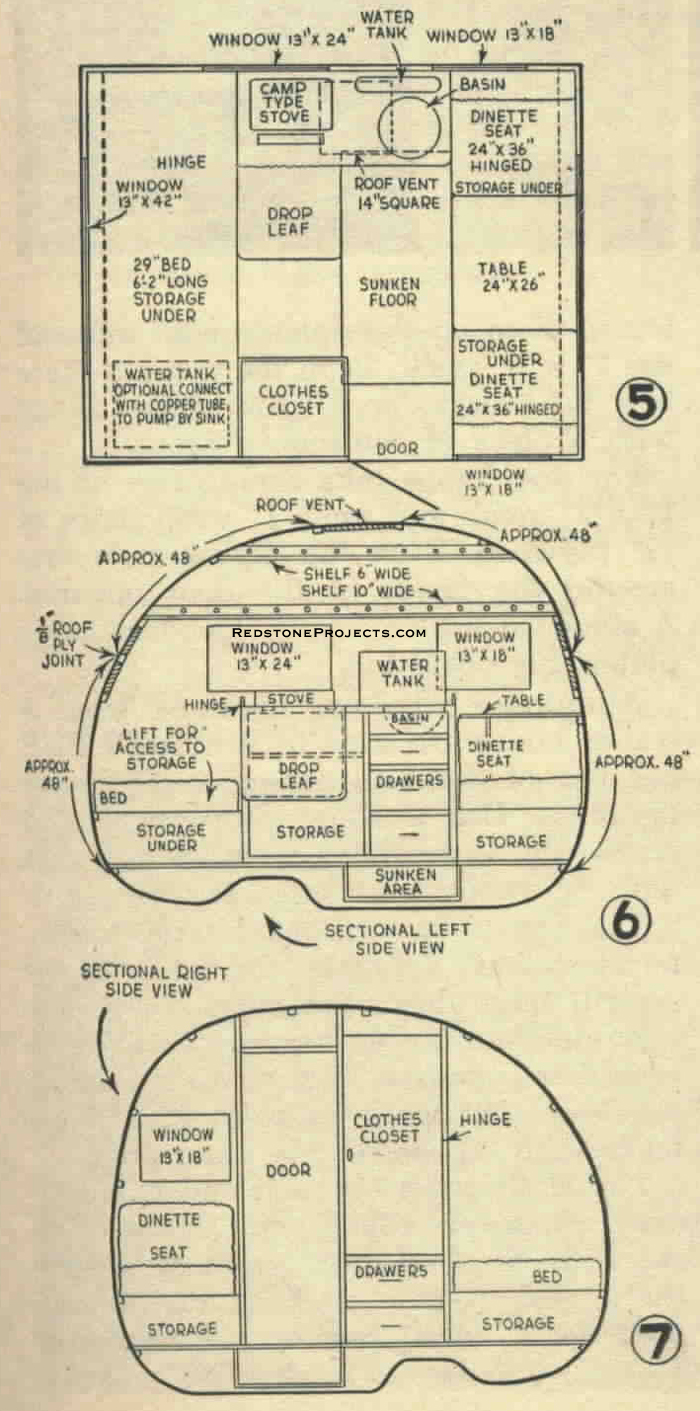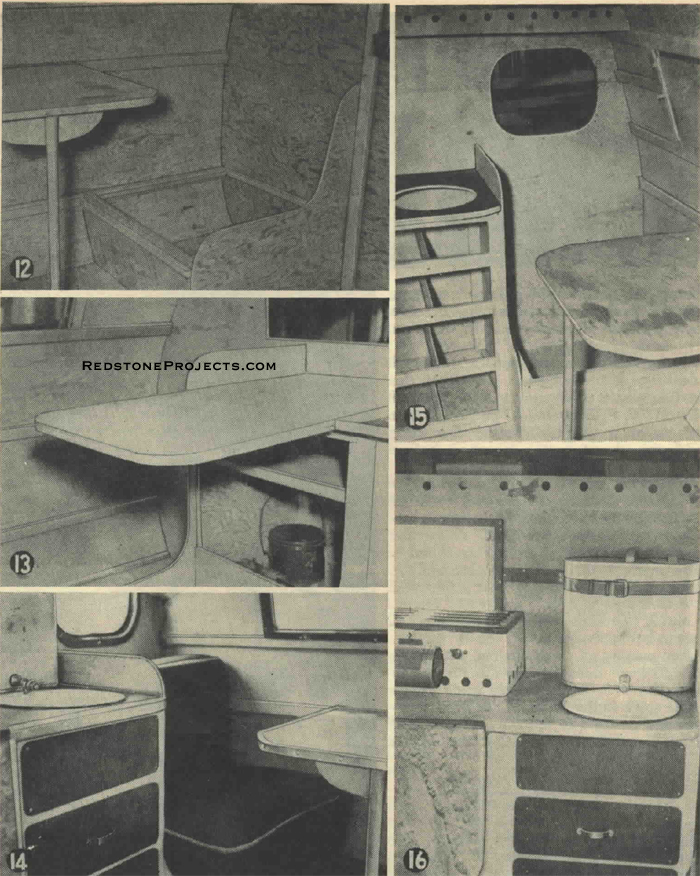 |
||||||||||||||||||||||||
|
All Orders Processed on a Secure Server Build a Lightweight Trailer for Two Vintage 1950's Do It Yourself Plans
"Wander Pup"
Begin by flooring the chassis. Take two pieces of 4' x 8' half-inch waterproof plywood and cut them to 6'4" in length.
Sawout on this outline with a jig or band saw. Before doing anything else take this side as a pattern and mark out a duplicate on two more pieces of the 1/4" plywood. Before putting on the outside studs and cleating, decide whether you want the station wagon effect shown in the finished WANDER PUP photo. If you do, it is a lot easier if you stain either the studs and the cleats or the plywood before building up the side. The studs are made of more of the 1" x 2" stock. I used a standard material carried by most lumber yards which actually measures 3/4" x 1 5/8". Allow for the window openings as in Figs. 3 and 4. The edging is made of scrap pieces of the 1/2" plywood from the floor and is jigsawed out as shown in Figs. 3 and 4 and Photos 6 and 7. The top and bottom of each stud has to be tapered to match the 1/2" edging.
Next mark the floor line on the inside face of the sides and temporarily affix two cleats to each side to hold it in position. Erect the sides in the right place in regard to the floor. Put plenty of waterproof glue on the frame stringers , and set up the sides again. Drill a 1/4" hole thru each stud and floor stringer and bolt with x 2" round head brass bolts. Use No. 8 1" round head brass screws between studs into the floor stringers. Now we're ready for the rafters. Cut eleven of them 6' 4 1/2" long out of the 1" x 2" stock. Check Photo 8 and the inset of Fig. 3 for the details of how these are fastened. Put glue in the notch, fit the rafter closely, and run a No. 7 1 1/2" flat head screw at an angle thru the rafter and into the edging. Countersink it in the rafter. After placing the rafters fix some cross pieces of rafter stock to frame the fore and aft window and roof vent openings. A 3" screw thru the rafter and into the ends of the crosspieces will hold them securely. Take a piece of 4' x 8' 1/8" plywood and glue and screw it to the cross stringer at the floor line. Its upper edge will come about half way up to the window opening. Place another short rafter between the side and window edge for fastening this piece. Place it so that the 1/2" plywood covers only the bottom half. The upper half is for fastening the next roof section. Glue and screw this piece to the side edges and the rafters with No. 5 5/8" flat head screws. Keep the screw heads in as far as possible from the outside edge to allow for rounding off the corners later. When this piece is fitted saw out the section that covers the lower half of the window opening. Then fit another piece of the 1/8" plywood above the one already placed. This will have to be trimmed to the middle line of the rafter bordering the roof vent. Now fit the two similar pieces at the other end. On top fill in on each side of the vent with a piece of the 1/8" plywood and the roof is finished. Next take a drawshave and a coarse wood rasp and round off the edges of the upper portion (Photo 9) . This doesn't have to be done, but it makes a neater job. Get a small roll of upholsterer's cotton from an upholstery shop for padding and insulating the top. This feature isn't actually necessary either, but when the trailer is parked in the hot sun you'll be glad it's there. Spread the top section with slow-drying glue and cover it with the cotton as shown in Photo 10. The muslin roofing covers not only the top section but the entire ends as well. The builder has found that 'exposed plywood when bent will check and deteriorate long before straight sections. Stretch and tack the cloth over the entire roof and ends using small copper tacks. This material is known in the trailer trade as cast iron muslin and can be bought at a trailer supply store. It need not be in one piece as the waterproofing solution used later will take care of any seams. On the front and rear sections the material must be cemented with water-proof canvas or linoleum cement. Do the whole job carefully so that a smooth surface is obtained. At the window and vent openings place most of the tacks on the inside face of the framing (see Photo 11). The door comes next. Take the two pieces cut when making the sides and frame them on the outside with more of the 1" x 2" stock. Trim the door so there is a 1/2" margin on all four sides. Hinge with a piece of continuous hinge. For door stops take some more of the 1" x 2" stock and some 1" wide strips of 1/4" plywood. Tack the plywood on first around the inside of the door opening. A standard trailer supply door lock completes this operation. Aluminum windows obtained from a trailer house are used in WANDER PUP because of their all around quality and lightness. Use a waterproof sealer and screw them securely every two inches with 3/4" round head brass screws. The top is waterproofed with a material called Topbrite. It is a heavy asphalt base aluminum paint and is obtainable from trailer supply stores. There are other brands of the same stuff which probably will work as well. This finish makes the top absolutely waterproof. The cloth covering each end is enameled whatever color you choose. The sides are finished with one coat of synthetic resin sealer, such as Firzite, and then coated with two or more coats of the best quality outside spar varnish. After painting, mouldings make a complete job. I used two strips of bending oak 1/2" x 3/4" screwed over the cloth edge around the top section. The ends and lower edges are covered with an aluminum moulding 3/4" x 3/4" set in a waterproof sealer and fastened with oval head drive screws 1" long. A piece of 3/8" x 1" wood moulding is screwed over the joint between the aluminum painted top and the enameled ends extending from the lower edge of the fore and aft windows to each side. Small pieces of sheet aluminum can be cut out and trimmed to make a neat joint where the three mouldings meet about half way up on the ends of each side.
| ||||||||||||||||||||||||
|
A study of Photos 13, 14, 15 and 16 will show the
details of the interior construction. Quarter inch plywood and 1" x 2"
framing is used.
Purchase a dinette cushion set and a rear bed cushion from a trailer supply house, rather than try to make your own; it is much more satisfactory. The dinette cushions are hinged and slide down quickly to make up into a good bed. Cushion dimensions are shown in Fig 5. The table is hinged on an end rafter so that it will swing up to the ceiling at night. The table leg also is hinged and is made as shown in Photo 12. The drop leaf pictured in the galley is necessary as kitchen work space is too limited without it. Two drawers are shown below the clothes closet (Fig. 7) and three below the galley sink (Photos 14, 15 and 16). They are made of 1/2" plywood for the sides and bottom with 3/8" plywood for the front and back. Outside faces for the drawers that overlap for a good joint are of 1/4" plywood. The sink is drained with a hose bent back against the wall and extending thru a hole in the floor. The shelves over the galley are of 1/4" plywood. A gasoline hot plate makes a satisfactory stove. The water tank and round basin sink are standard trailer supply items. Interior finish used was a stain wax in a silver gray color. It is easy to apply, requires only one coat, and looks very nice. |
|
|
|
|
